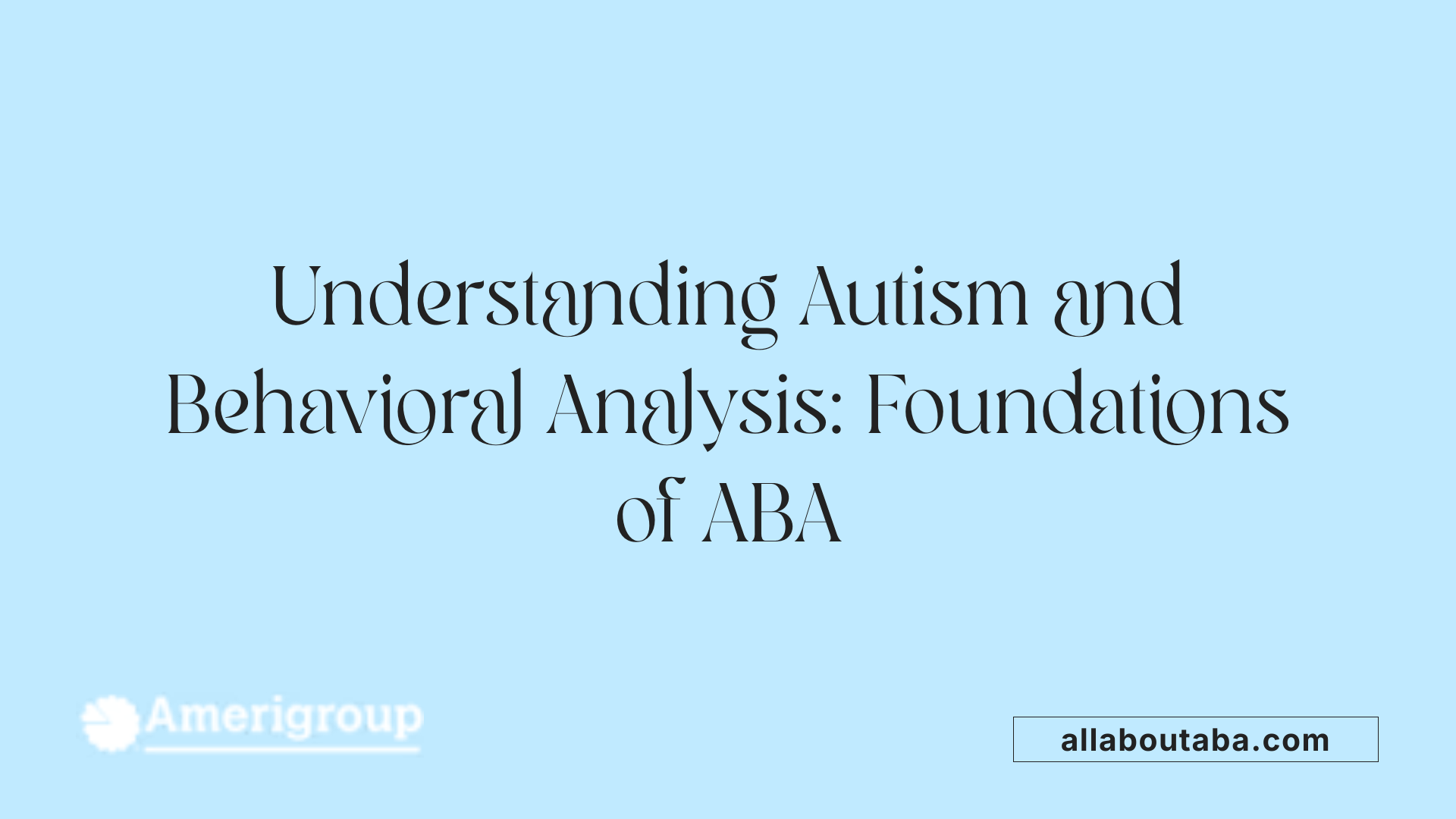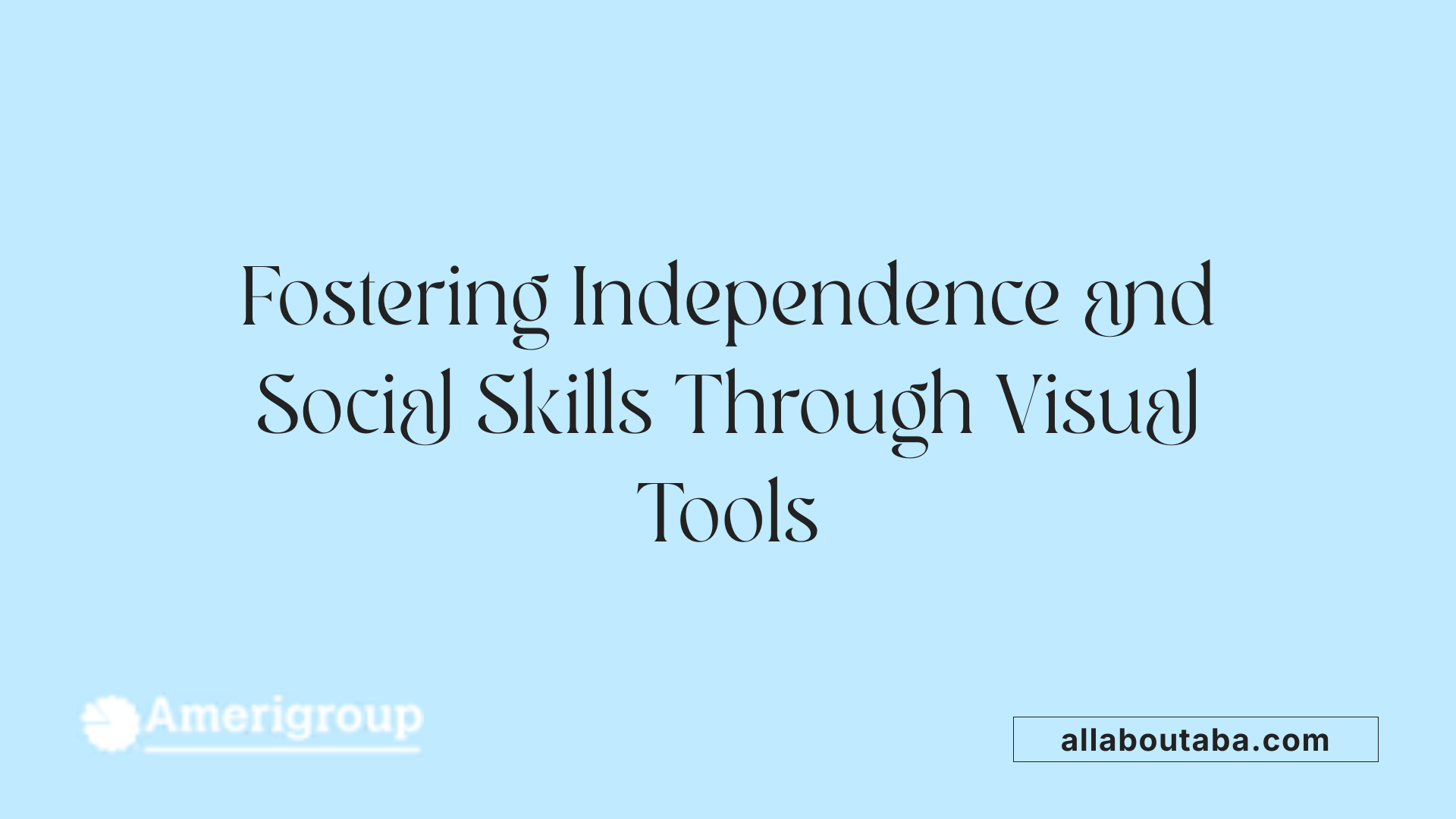Understanding Visual Supports in Autism Education
Visual supports have become a cornerstone in autism education, offering children with autism spectrum disorder (ASD) vital tools for communication, learning, and social interaction. These aids — ranging from picture schedules to emotion charts — help bridge gaps in verbal communication and provide structure, reducing anxiety and improving independence. This article explores how visual supports function within autism therapy and education, the benefits they bring, and best practices for their implementation.
What Is Autism Therapy Focusing on Behavioral Analysis?

What is therapy focusing on autism and behavioral analysis?
Therapy focusing on autism and behavioral analysis primarily refers to Applied Behavior Analysis (ABA). ABA is a research-based and evidence-supported approach designed to improve social, communication, academic, and daily living skills in individuals with autism.
Definition and goals of Applied Behavior Analysis (ABA) therapy
ABA aims to understand behaviors by examining their antecedents and consequences, known as the ABCs (Antecedent, Behavior, Consequence). The therapy's main goal is to increase helpful behaviors and reduce harmful or interfering behaviors. Ultimately, ABA supports greater independence, social engagement, and an improved quality of life.
Techniques used in ABA
ABA uses varied techniques tailored to individual needs, including discrete trial training, pivotal response treatment, and naturalistic interventions like the Early Start Denver Model. These strategies help teach important skills and reduce challenging behaviors through consistent positive reinforcement.
Role of professionals in ABA therapy
ABA therapy is delivered by trained professionals, often overseen by a Board Certified Behavior Analyst (BCBA). These experts continually evaluate progress, adjust goals, and collaborate closely with families to ensure appropriate and effective interventions.
How ABA supports individuals with autism
By focusing on behavior functions, ABA helps individuals develop essential social and communication skills. Visual supports and aids are often incorporated into ABA to enhance understanding and facilitate learning. This approach empowers individuals with autism to navigate daily life with increased independence and confidence.
How Visual Supports Facilitate Communication and Understanding
Types of visual supports and their communication role
Visual supports encompass a variety of tools such as pictures, objects, written words, photographs, picture schedules, visual calendars, choice boards, social stories, and visual timers. These aids provide structure and clarity, helping children with autism better understand their daily routines, instructions, and social cues. Personalized visual aids crafted by caregivers or educators can be tailored to the unique needs of each child, ensuring relevance and effectiveness.
How visual supports provide alternative communication methods
For many children with autism, verbal communication can be challenging. Visual supports offer alternative ways to express needs and preferences, bridge gaps between thoughts and actions, and facilitate clearer self-expression. Tools like the Picture Exchange Communication System (PECS) enable nonverbal or preverbal children to communicate by exchanging images representing their desires or feelings. This approach significantly enhances communication abilities and interaction quality.
The enhanced processing of visual information in children with autism
Children with autism often have an increased ability to process visual information compared to auditory input. This heightened visual processing makes visual supports particularly effective, as these children can more readily interpret pictures or symbols than spoken words. Leveraging this strength can improve understanding and reduce communication barriers.
Examples like Picture Exchange Communication System (PECS) and emotion charts
PECS is a widely used visual communication method where children learn to exchange picture cards to convey messages. Complementing this, emotion charts can help children recognize and communicate their feelings, supporting emotional regulation. Visual schedules and timetable cards promote predictability by outlining daily activities, reducing anxiety, and facilitating smoother transitions.
These strategies form part of evidence-based practices incorporated in therapies like Applied Behavior Analysis (ABA), which emphasize positive reinforcement and individualized support. Consistent use of visual supports across home, school, and therapy settings further reinforces learning and generalization of skills.
Reducing Anxiety and Building Predictability through Visual Aids

How do picture schedules, visual calendars, and transition aids reduce anxiety in children with autism?
Visual supports like picture schedules, visual calendars, and transition aids offer clear and consistent visual cues that help children with autism anticipate what will happen throughout their day. By making daily activities and transitions visually explicit, these tools reduce uncertainty and provide structure, which significantly lowers anxiety levels. This predictability helps children feel more secure and less overwhelmed.
How do visual supports prepare children for transitions and routine changes?
Transitions and changes in routines can be challenging for children with autism. Visual supports serve as advance warnings and guides that prepare them for upcoming events. For example, visual timers or transition cards signal when an activity is ending and another is beginning, helping the child adjust smoothly. This preparation fosters a sense of control and readiness, reducing resistance and confusion during changes.
What impact do visual aids have on behavioral challenges and meltdowns?
By providing a clear representation of what to expect, visual supports decrease anxiety that often triggers behavioral challenges and meltdowns. When children understand the sequence of activities and anticipate transitions, they are less likely to experience stress-related outbursts. Visual aids can also offer alternative ways to communicate feelings or needs, further preventing frustration and behavioral episodes.
What role does consistency of visual supports across environments play?
Consistency is vital for reinforcing skills and ensuring children generalize their learning across home, school, and community settings. Using the same types of visual aids in multiple environments helps children recognize and rely on these supports regardless of location. This uniform approach strengthens the child's independence, reduces anxiety, and promotes smoother interactions throughout different contexts.
Promoting Independence and Social Skills with Visual Supports

How Can Visual Supports Teach Daily Living Skills Like Dressing and Ordering Food?
Visual supports, such as picture cards and step-by-step visual schedules, play a crucial role in teaching daily living skills to children with autism. For example, pictures outlining the steps to dress or order food empower children to complete these tasks independently. This visual guidance reduces reliance on verbal instructions and helps them learn routines through clear, repeatable cues.
In What Ways Do Visual Supports Enhance Social Interaction with Peers and Caregivers?
Visual aids help break down communication barriers by enabling children with autism to express themselves more clearly. Using pictures, emotion charts, or choice boards facilitates interactions with peers, family members, and caregivers. These tools create a shared understanding and help children navigate social cues, reducing feelings of anxiety or being overwhelmed during social exchanges.
How Do Visual Supports Decrease Caregiver Burden?
By promoting independence, visual supports lessen the constant need for caregiver prompts and supervision. When children use visual aids to manage routines like brushing teeth or selecting clothes, caregivers can focus on other tasks with less stress. This empowerment not only supports the child's growth but also creates a more balanced dynamic within the family or care environment.
How Are Visual Supports Used to Foster Self-Management?
Visual supports help children develop self-management skills by clearly outlining what is expected and providing cues for upcoming activities or transitions. Tools such as visual timers, schedules, and personalized charts encourage children to regulate their behavior and complete tasks with minimal assistance. Involving children in customizing these aids can increase engagement, motivating them to take ownership of their routines.
Consistently integrating visual supports across home, therapy, and educational settings strengthens learning and enables children with autism to generalize new skills, leading to greater independence and improved social interaction.
Integrating Visual Supports into Evidence-Based Interventions

How can visual supports be combined with ABA therapy?
Visual supports are most effective when integrated into evidence-based interventions like Applied Behavior Analysis (ABA). ABA therapy focuses on understanding the functions of behavior and utilizes positive reinforcement to encourage socially appropriate actions. When visual aids such as picture schedules, choice boards, or social stories are paired with ABA strategies, children with autism can better understand routines, instructions, and social cues, leading to improved communication and behavior.
What role does positive reinforcement play alongside visual aids?
Positive reinforcement in ABA therapy strengthens desirable behaviors by rewarding children when they respond correctly to visual supports. For example, when a child uses a picture exchange communication system (PECS) to request an item, immediate praise or a tangible reward encourages consistent use of this communication method. This synergy between visual aids and reinforcement builds skills more effectively than either would alone.
How are visual supports personalized and assessed over time?
Personalization is essential to meet each child's unique needs. Caregivers and educators are encouraged to create customized visual supports tailored to the child’s preferences and abilities. Additionally, regular professional review ensures these tools continue to support the child’s evolving communication and learning goals. This ongoing assessment helps adapt supports to maintain engagement and effectiveness.
What professional support is recommended for implementing visual aids?
Collaboration with professionals such as speech-language pathologists (SLPs) is recommended to select appropriate augmentative and alternative communication (AAC) strategies. Therapists and educators also assist in the design, implementation, and evaluation of visual supports to ensure they complement other interventions. This team-based approach maximizes the benefits of combining visual aids with evidence-based practices like ABA.
| Aspect | Description | Benefit |
|---|---|---|
| Visual Supports | Picture schedules, social stories, choice boards | Enhance understanding of routines and instructions |
| ABA Therapy | Applied Behavior Analysis with positive reinforcement | Improves behavior and skill acquisition |
| Personalization | Customized visual aids tailored to individual needs | Increases engagement and effectiveness |
| Professional Involvement | Support from SLPs, therapists, educators | Ensures appropriate use and ongoing assessment |
Creating and Customizing Visual Supports: Collaboration and Resources

Involving Children in Creating Visual Aids to Boost Engagement
Engaging children with autism in the creation of their own visual supports can significantly enhance their motivation and connection to these tools. Personalizing aids like picture cards or emotion charts allows children to express their preferences and feel ownership, which often leads to increased use and effectiveness.
Use of Cost-Effective Resources from Organizations like Autism Speaks
Families and educators can utilize free or low-cost resources provided by respected organizations such as Autism Speaks and the University of Florida. These resources offer guidance, templates, and ideas for developing visual supports tailored to individual needs, making implementation accessible regardless of budget.
Types of Visual Supports Including Picture Cards, Digital Photos, and Timers
Visual supports come in various forms to suit diverse learning styles and environments. Common aids include picture cards, digital photographs, visual schedules, and timers. Visual timers help children understand time-related transitions, while digital photos add a personal touch to familiar objects or people, enhancing comprehension.
Supporting Caregivers and Educators in Visual Support Implementation
Caregivers and educators are encouraged to collaborate in the design and use of visual supports. Professional consultation, especially with speech-language pathologists and therapists at centers like ABA Centers of Florida, can assist in selecting appropriate augmentative and alternative communication strategies. Regular review and adjustment of visual aids ensure they align with evolving needs, promoting consistent skill development across settings.
Broader Benefits and the Role of Visual Supports in Autism Education
How Do Visual Supports Improve Communication, Understanding, and Behavior in Children with Autism?
Visual supports serve as an essential tool for children with autism by providing alternative communication methods. They help children express themselves more clearly, bridging gaps between their thoughts, feelings, and actions. These aids enhance social interactions by enabling children to connect with peers, family members, and caregivers without feeling overwhelmed. Using visual supports such as picture schedules, emotion charts, and visual timers supplies structure and predictability, reducing anxiety and minimizing behavioral challenges especially during transitions.
Why Is Early Intervention Important, and Can Visual Supports Benefit Individuals at Any Age?
While early intervention is recognized as the most effective stage for autism treatment, visual supports offer significant advantages for all ages. Incorporating these tools can boost communication and social skills regardless of developmental stage. The adaptability of visual aids allows them to remain valuable whether introduced in early childhood or later, enhancing overall quality of life by promoting independence and understanding.
How Does Consistency Across Settings Reinforce Skills?
Consistent use of visual supports across multiple environments such as home, school, and therapy sessions reinforces learning and helps generalize skills to everyday life. When children repeatedly encounter the same visual cues and supports, it fosters familiarity and strengthens comprehension. This continuity reduces reliance on verbal prompts and supports self-management.
What Role Do Visual Supports Play Within Evidence-Based Autism Practices?
Visual supports are a critical component of evidence-based interventions for autism, including Applied Behavior Analysis (ABA). ABA programs integrate visual aids to teach socially appropriate behaviors and reduce interfering behaviors through positive reinforcement. Recognized as one of twenty-eight validated practices for autism, visual supports align well with scientific research advocating individualized, collaborative, and family-centered approaches. Professional guidance from therapists ensures that visual aids are tailored to the child’s evolving needs, maximizing their effectiveness.
| Aspect | Description | Examples of Visual Supports |
|---|---|---|
| Communication and Understanding | Provides nonverbal tools that clarify messages and aid emotional expression. | Picture Exchange Communication System (PECS), emotion charts |
| Behavioral Outcomes | Reduces anxiety, overcomes challenges during transitions, and improves social interactions. | Visual schedules, transition aids, social stories |
| Skill Generalization and Independence | Reinforces learning across environments, promotes self-management, and decreases caregiver burden. | Visual calendars, choice boards, digital photos |
| Integration in Evidence-Based Practices | Part of scientifically validated techniques to promote socially appropriate behavior and skills. | Included in ABA therapy, naturalistic interventions |
Conclusion: Visual Supports as Essential Tools in Autism Education
Visual supports stand as powerful, adaptable tools that unlock new potentials for children with autism, enhancing communication, fostering independence, lowering anxiety, and improving social engagement. When integrated thoughtfully within evidence-based interventions like Applied Behavior Analysis, these visual aids contribute significantly to personalized and effective autism education. From simple picture cards to complex systems like PECS, their consistent application across home and educational settings strengthens skill acquisition and generalization. Ultimately, involving professionals, caregivers, and the children themselves in selecting and customizing these supports ensures they meet evolving needs and maximize benefits. Visual supports are not just aids — they are gateways that help children with autism navigate their world with greater confidence and understanding.







